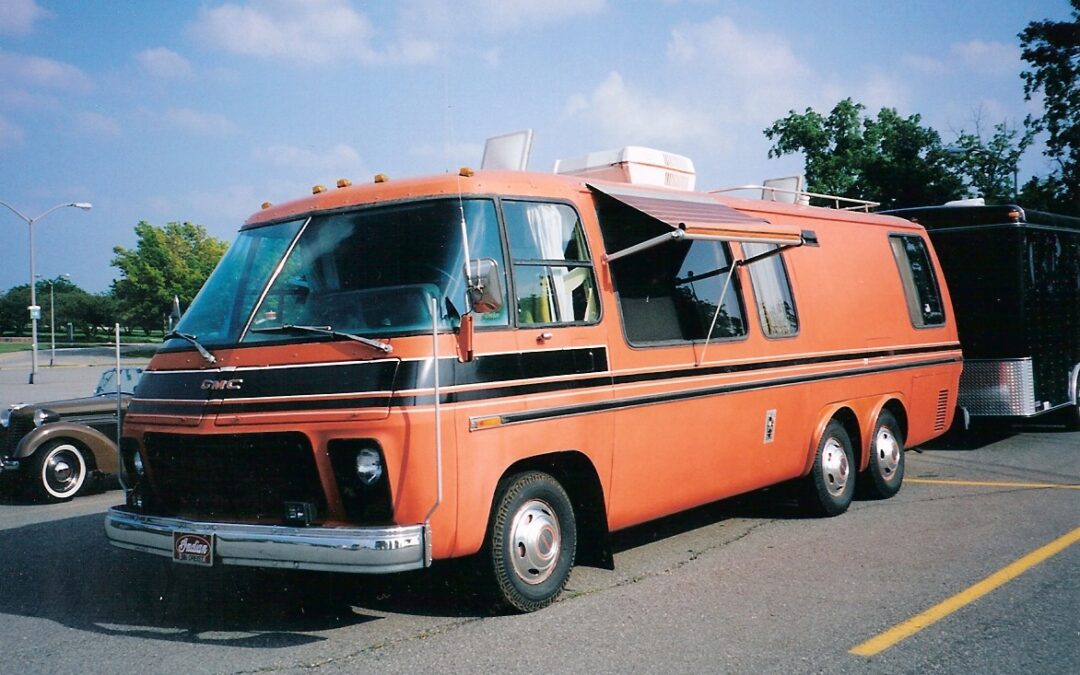When General Motors decided to enter the motor home business in the early 1970s it became the only automobile manufacturer to produce a complete recreational vehicle. Many supplied running gear and chassis’ to RV builders, but GM decided to do the job entirely themselves. They would also provide unfinished units to those wishing to build them with their own customized features.
The motorhome announcement by the formidable car company sent a chill through the RV industry. Shares of established RV manufacturers went into decline, although they eventually recovered.
Rather than the typical boxy shape produced by most RV manufacturers, GM opted for a low, sleek, easy-to-enter design that would be both handsome and practical.
GMC Truck and Coach Division in Pontiac, Michigan, who was assigned the project, sought a different approach to achieve the low silhouette that would provide both car-like highway driving and convenient camping.
The solution was found right in GM’s own inventory: the front-wheel drive engine and transaxle unit from the Oldsmobile Toronado introduced in 1966.
The 7.5 litre (455 cu. in.), overhead valve V-8 was installed longitudinally with the three-speed Hydramatic transaxle rotated 180 degrees and mounted on the left side of the engine. Power went to the transmission via a 51 mm (2 in.) wide chain. Since the usual coil springs would interfere with the halfshafts, front suspension was by longitudinal torsion bars.
Placing the entire drivetrain in the front eliminated the long driveshaft, and a pair of tandem rear wheels on each side intruded minimally on interior space. Without a driveshaft and rear axle meant the floor was only 356 mm (14 in.) above ground, lowering the centre of gravity and eliminating the need for a step to enter and exit.
The tandem wheels were carried on each side by a bogie system and suspension was by air springs inflated by an on-board compressor. This provided automatic levelling for travelling and made manual levelling available when setting up camp. It also provided good riding qualities for a motorhome. Braking was by discs in front and drums on all four rear wheels.
For long life the aluminum body skeleton was mounted on a ladder-type steel frame and stylishly clad in aluminum and fibreglass. Large windows were not only impressive in appearance, but provided wonderful visibility, although they did place an extra load on the air conditioning system.
Sleeping accommodation for up to six could be provided either by converting seats or the permanent beds fitted to some coaches. Although the GMC motorhome came in 7,010 mm (23 ft.) and 7,925 mm (26 ft.) lengths, the longer one was far more popular. Width was 2,438 mm (96 in.) and the nicely appointed interior had a height of 1,930 mm (76 in.).
Overall height, including the roof-mounted air conditioners, was 2,743 mm (108 in.). Wheelbases were 3,556 mm (140 in.) and 4,064 mm (160 in.) respectively, measured from the front axle to the centre of the rear wheel bogie. Weight was in the 5,443 kg (12,000 lb) range.
The GMC motorhome could be reasonably self-sufficient with an optional 4,000 or 6,000 watt Onan generator set and two 113 litre (25 gal) tanks for potable water and wastewater. The sleek shape, however, made it short of externally accessible storage compartments for such camping paraphernalia as tools, extension cords, ropes, etc.
With its ample power, low centre of gravity, power steering and cruise control, the GMC motorhome could cruise easily at normal highway speeds. It used regular gasoline at the rate of about 28 L/100 km (10 mpg) from two 96 litre (22 gal) fuel tanks.
This was quite competitive with the fuel consumption of other motorhomes, thanks in part to an aerodynamic body with a drag coefficient of only 0.31, good for this type of vehicle. A downside of front-wheel drive was reduced traction in hilly or slippery campgrounds.
The GMC motorhome was introduced in 1973 and was made until 1978. It remained basically unchanged for its production period. When fuel economy and supply concerns rose in the mid-1970s, the Oldsmobile engine was reduced to 6.6 litres (403 cu. in.) in 1977.
GMC built a total of some 13,000 motorhomes over the six year run. When introduced, they quickly began attracting a dedicated following, an enthusiasm that extends to today, some 40 years after production ended.
Many current owners have modernized them with better materials and newer engine technology. There are clubs devoted to preserving and enjoying them, and companies that stock parts for the estimated 9,000 still existing.
It is doubtful that General Motors made much, if any, money on its motorhome venture, but it did build a lasting legacy. It’s a good example of what the huge resources and talent of a large company can do, when it ventures into something different.

